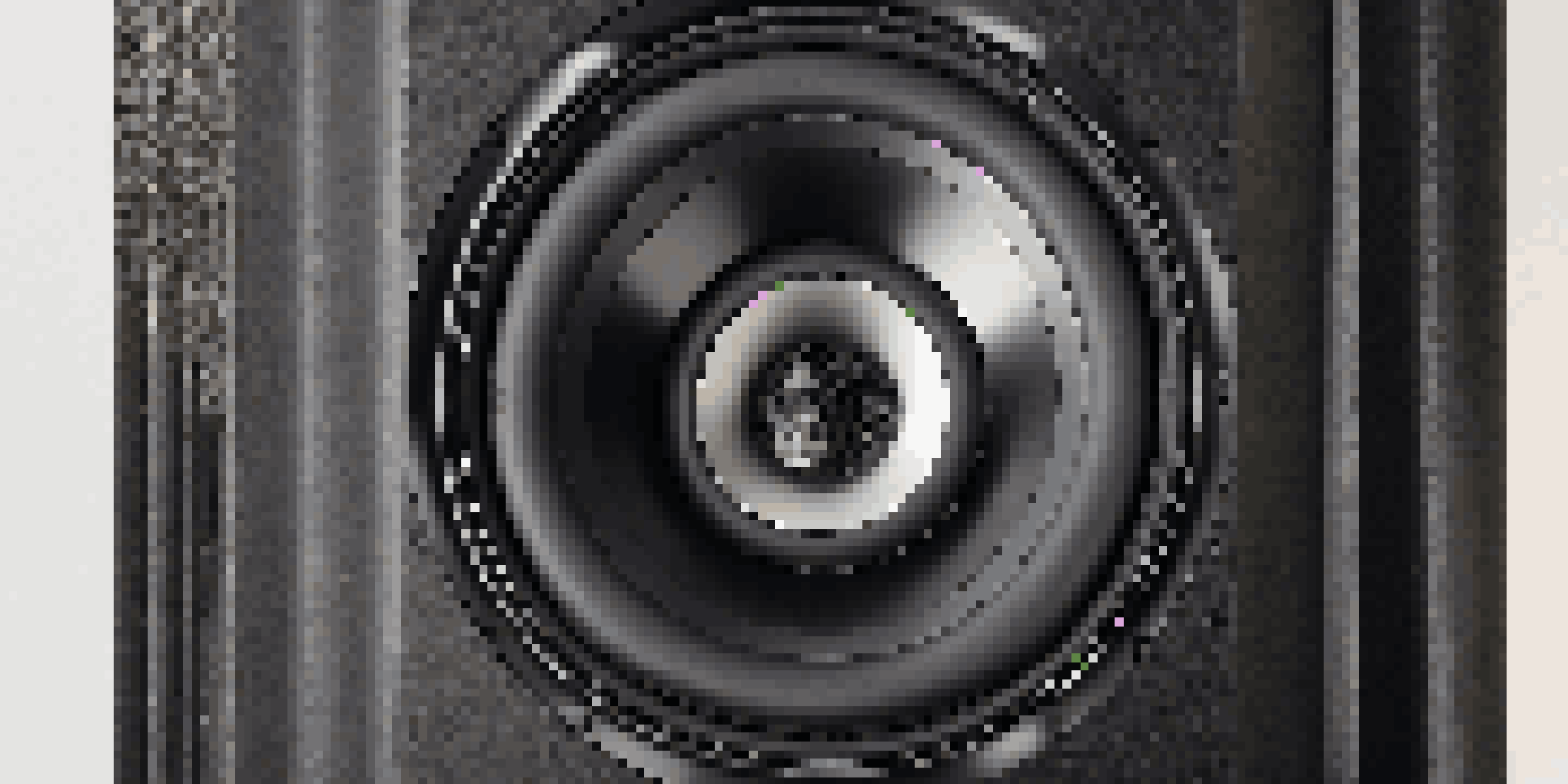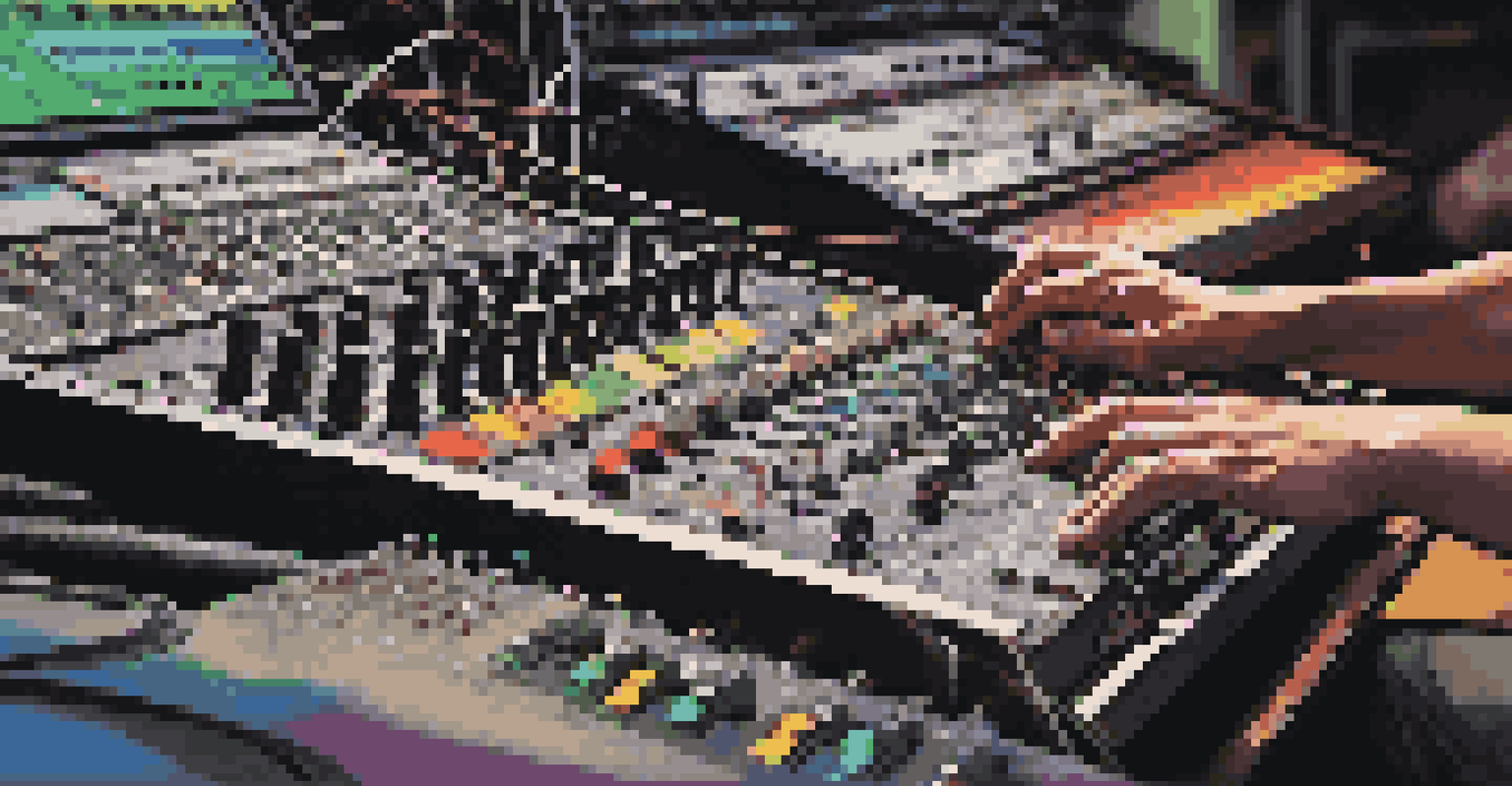Exploring the Use of Subwoofers in Live Sound Engineering

Understanding Subwoofers and Their Role in Sound Systems
Subwoofers are specialized speakers designed to reproduce low-frequency sounds, typically ranging from 20 Hz to 200 Hz. These frequencies are crucial for creating a rich, full sound experience, especially in genres like electronic, hip-hop, and rock music. Without subwoofers, the sound can feel thin and lacking depth, making the overall audio experience less engaging.
The bass is the foundation of a song, the heartbeat that drives the rhythm forward.
In live sound engineering, subwoofers help to balance the audio mix by providing the bass foundation that supports other instruments. This is why you often see them paired with full-range speakers during concerts and events. By delivering those deep rumbling sounds, subwoofers elevate the listening experience, allowing audiences to feel the music as much as they hear it.
Moreover, subwoofers can influence the energy of a live performance. When the bass hits just right, it can resonate with the crowd, creating an emotional connection that enhances the overall atmosphere. This is particularly important for live events where the audience's engagement can make or break the experience.
Key Components of Subwoofer Design
Subwoofers come in various designs, but they generally include a driver, an enclosure, and an amplifier. The driver is the speaker cone that produces sound, while the enclosure is the box that houses the driver and impacts sound quality. The amplifier boosts the audio signal, ensuring the bass is powerful enough to fill the venue.

Different types of subwoofer designs exist, including sealed and ported enclosures. Sealed enclosures provide tight, accurate bass, making them ideal for genres that require precision. In contrast, ported enclosures allow for more volume and boom, which can be perfect for high-energy performances.
Subwoofers Enhance Sound Depth
Subwoofers reproduce essential low frequencies, providing a rich audio experience that elevates genres like electronic and rock music.
Understanding these components helps sound engineers choose the right subwoofer for their specific needs. It's not just about having a subwoofer; it's about selecting one that complements the overall sound system and meets the requirements of the venue and the performance style.
Placement of Subwoofers for Optimal Sound Quality
The placement of subwoofers in a live setting can significantly impact sound quality. Ideally, subwoofers should be positioned to minimize phase cancellation, a phenomenon that can muddy the bass response. Placing them near walls or in corners can enhance low-frequency output, but it can also lead to uneven sound distribution.
Good sound is all about balance; it’s about getting the bass and treble to work together in harmony.
A common practice in live sound is to use multiple subwoofers, strategically placed around the stage. This setup not only provides a more balanced bass response throughout the venue but also creates a more immersive experience for the audience. When subwoofers are well-placed, the bass feels consistent, no matter where you are in the crowd.
Sound engineers often conduct sound checks and make adjustments to subwoofer placement before events. This attention to detail ensures that the bass complements other elements of the sound, creating a cohesive audio experience that resonates with the audience.
The Importance of Subwoofer Tuning in Live Sound
Tuning subwoofers is a critical step in live sound engineering, as it ensures that the bass frequencies are balanced with the rest of the audio spectrum. This involves adjusting settings on the soundboard and using equalizers to fine-tune the output. Proper tuning can prevent issues such as excessive boominess or a lack of clarity in the bass.
Engineers often use measurement microphones and software to analyze the sound in the venue. This technology allows them to visualize how the bass interacts with the room, making it easier to identify problem areas. By making precise adjustments based on this data, sound engineers can achieve a more refined and enjoyable listening experience.
Optimal Placement is Essential
Strategically placing subwoofers minimizes sound issues and ensures consistent bass response across the venue.
Ultimately, the goal of tuning is to create a sound that is both powerful and clear. A well-tuned subwoofer not only enhances the music but also ensures that the audience can enjoy every detail of the performance without being overwhelmed by excessive low frequencies.
Different Types of Subwoofers for Live Events
There are several types of subwoofers available for live sound applications, each with its unique advantages. For instance, active subwoofers come with built-in amplifiers, making them easier to set up and manage. They are often favored for smaller events where simplicity and efficiency are key.
On the other hand, passive subwoofers require an external amplifier, which can offer more power and flexibility in larger setups. This type is typically used in professional concert settings where sound engineers need to customize their equipment for optimal performance. The choice between active and passive often comes down to the scale of the event and the specific sound requirements.
Additionally, some subwoofers are designed for specific applications, such as portable models for mobile DJs or rugged versions for outdoor festivals. Understanding these options helps sound engineers select the right equipment to match the demands of their event and deliver the best possible audio experience.
Common Challenges When Using Subwoofers Live
Using subwoofers in live sound can come with its set of challenges. One common issue is feedback, which can occur when the sound from the subwoofer re-enters the microphone, creating a loop that amplifies unwanted noise. Proper positioning and tuning can help minimize this risk, but it requires constant vigilance by the sound engineer.
Another challenge is managing the acoustics of the venue. Each location has unique characteristics that can affect how sound travels, particularly low frequencies. In some cases, certain spots may experience excessive bass, while others may feel lacking. Engineers often need to adapt their setups to accommodate these variations.
Tuning Improves Audio Clarity
Proper tuning of subwoofers balances bass with other frequencies, enhancing overall sound quality and audience enjoyment.
Lastly, power management is crucial when dealing with multiple subwoofers. Ensuring that each unit receives adequate power while preventing distortion can be tricky. Sound engineers must carefully calculate and manage power loads to avoid damaging equipment and ensure consistent performance throughout the event.
Best Practices for Integrating Subwoofers in Live Sound
Integrating subwoofers into a live sound setup requires careful planning and execution. One of the best practices is to conduct a thorough sound check before the event begins. This allows engineers to make necessary adjustments and ensure that all speakers, including subwoofers, work harmoniously together.
Another key practice is to maintain clear communication with the performers and other crew members. Understanding the artists' expectations regarding bass levels can guide the engineering process and help create the desired sound. Collaboration often leads to a better overall experience for both the performers and the audience.

Finally, staying up-to-date with advancements in subwoofer technology can enhance a sound engineer's toolkit. New equipment and software can offer improved sound quality, efficiency, and ease of use, ultimately leading to a more successful event. Embracing these innovations keeps sound engineers at the forefront of live sound engineering.